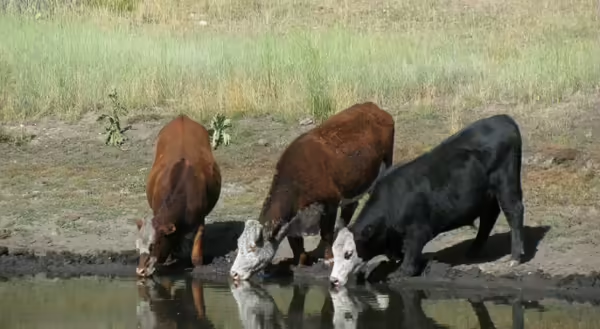
Having access to water is a crucial component of any grazing system. Pastures look different depending on the type of grazing system utilized. If you are designing a new pasture or changing a current one, placing and planning for water access should be near the top of your list. Water quality is also important when it comes to the overall health and well-being of the animals. Creeks and ponds are natural water sources that can be used for cattle on pasture. While natural water sources are convenient, there are pros and cons to using them.
Pros
Natural water sources like creeks and ponds can be useful in pasture systems. These systems require little maintenance when there is adequate precipitation. Pre-existing ponds and creeks are low-cost water sources that can increase the land value of your pasture and are convenient to use for cattle. Instead of allowing unrestricted access, limiting water access can prolong the life of the source. Installing temporary fencing around the pond or creek and leaving a 20–40-foot gap can help to reduce bacteria from manure and excess sediment. Using a heavy-duty ramp or installing geotextile with a few layers of rock on top can be used at the access point to reduce the impact of heavier foot traffic. Limiting access can also decrease the risk of drowning and other physical hazards.
Cons
Natural water sources can also cause animals a series of issues. As livestock congregate in ponds and creeks, there is an increased risk of disease and parasite transmission. Feces can contaminate the water, leading to decreased water quality and increased algae growth. Fertilizer, herbicide, and urban area runoff could also potentially contaminate creeks and streams. In periods of drought, these water sources can become unreliable. As water levels lower, steep banks can make it difficult for cattle to reach water. Giving cattle unrestricted access to ponds and creeks can also increase the risk of physical hazards such as drowning or sinking in mud.
Using Ponds to Fuel Waterers
Ponds can also be used to fill gravity-flow-fed water tanks. If the pond is completely fenced off, it is possible to run a pipe under the pond and through a dry dam. Installing a valve on the dry side of the dam allows you to control the water flow. In turn, a gravity-flow fed water tank can be installed on the down slope side of the pond. Fencing off the pond can help to prevent water quality and safety issues among the cattle. Laying pipe, while more expensive, allows for utilization of the natural water source without sacrificing water quality.
Maintaining Water Quality
It is important to test any water source to ensure that it can be safely consumed. You can check water quality using a livestock water analysis and taking samples from your sources. Testing for nitrates, sulfates, salinity, pH, TDS, and toxic factors like pesticides is recommended. After taking and labeling water samples, contact your local Extension agent to assist you in taking the next steps.
Summary
Allowing cattle to use natural water sources responsibly can dramatically decrease your water costs. It’s important to check cattle with access to natural water sources at a minimum once daily to ensure the safety of the animals. Timely deworming of cattle can help to keep parasite numbers low, and monitoring water quality allows performance and growth better chances at success.
About the Author
Mabry Bruhn is a student at the University of Illinois Urbana-Champaign who works in beef production, research, and producer outreach as a University of Illinois Extension intern in the I-BELIEF program through the Department of Animal Sciences in the College of Agricultural, Consumer and Environmental Sciences. This article has been reviewed by Extension Commercial Agriculture Educator, Travis Meteer.